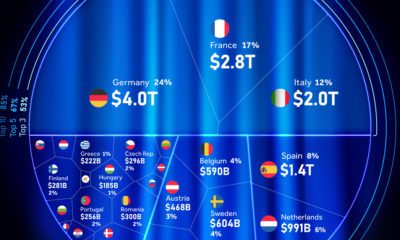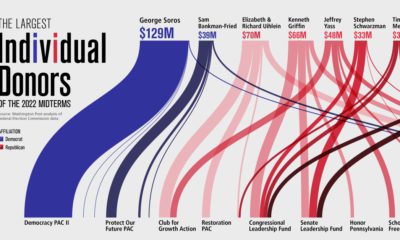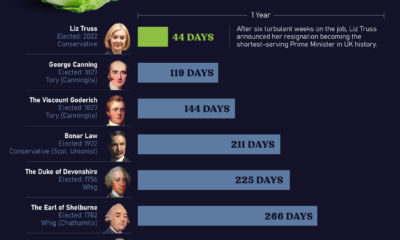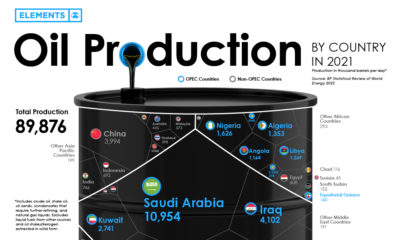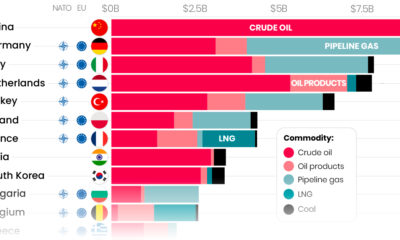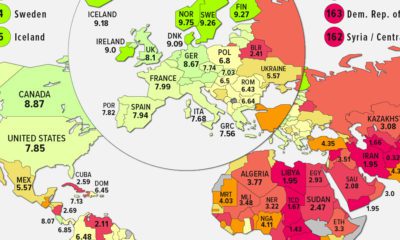Because no candidate received a majority of votes, there will be a run-off vote on May 7 in which French voters decide between Emmanuel Macron and Marine Le Pen. While the two candidates are each considered outsiders for different reasons, their key platform differences could not be more stark. The major fundamental issue they disagree on is EU membership – and as a result, French voters potentially hold the fate of the entire EU in their hands.
Head-to-head: Macron vs. Le Pen
Today’s infographic is from Swissquote, and it compares the platforms of Macron and Le Pen head-to-head. Here are some of the key differences between the two: Background: Emmanuel Macron is an investment banker that was the Minister of the Economy for François Hollande’s government. He left in 2016 to start En Marche!, a centrist political movement that describes itself as “neither right nor left”. Marine Le Pen has been the leader of the National Front since 2011, and is a lawyer by trade. She is the youngest daughter of National Front founder Jean-Marie Le Pen, and has worked in politics since 1998. She’s also been a Member of European Parliament since 2004. European Union: Macron wants to remain in the European Union and to seek a common asylum policy. Meanwhile, Le Pen wants to hold a referendum on France’s EU membership, while re-instating a national currency. Economic Policies: Macron wants to cut government spending to 50% of GDP, to limit the wealth tax to real estate, and to cut the corporate tax rate from 33.3% to 25%. Le Pen supports re-industrialization of France as well as “intelligent protectionism”. She wants to allow the Banque de France to print money to fund the treasury up to an annual maximum of 5% of total money supply, and also advocates a 10% cut for the lowest income tax brackets. Security: Macron wants to stay in the Schengen border-free zone, while Le Pen wants to exit it. Both want to hire new police officers and to add new prison spaces, though Le Pen wants to add higher amounts of each. Le Pen also wants to cut legal immigration to France to 10,000 per year. Military: Both Macron and Le Pen want to re-introduce military conscription for short periods of time. Each wants to increase defense spending, as well: Macron by 2% by 2025, and Le Pen by 3% of GDP by 2022. Labor: Both want to keep the 35-hour work week, although with some exceptions. Macron wants to extend unemployment benefits to entrepreneurs, farmers, self-employed, and those who quit jobs voluntarily. He also wants to implement a universal pension system, and to boost training schemes for unemployed youth. Le Pen advocates the lowering of the retirement age to 60, and for a “purchasing-power bonus” of €1,000 a year for low-wage earners and pensioners. She also wants a national plan for equal pay for women, and for overtime to be tax-free. Environment: Macron is opposed to the exploitation of shale gas and offshore drilling, and wants the remaining coal-fired plants in France to be closed. Le Pen calls for a move to a “zero-carbon” economy, and to ban shale gas exploration, while setting a moratorium on windmills for power generation. Le Pen also would like to ban GMOs. Education: Macron says up to 5,000 new teaching jobs should be created. Le Pen wants there to be no free education for children of illegal immigrants, and to restrict the use of foreign languages in schools. She also thinks school uniforms should be mandatory. Civil Liberties: Macron supports same-sex marriage, while Le Pen wants to scrap the 2014 law allowing same-sex marriage and to replace it with civil unions. Macron supports medically assisted procreation for lesbians, but opposes recourse to surrogate mothers by homosexual couples. Le Pen wants to ban surrogacy and to restrict medically-supported procreation to people with sterility problems. Governance Both candidates want to introduce some degree of proportional representation to the electoral system, though Le Pen wants to take it further. Macron wants to cut 120,000 state jobs by not replacing retiring civil servants. Le Pen wants to put French flags on all public buildings, to cut the number of lawmakers in the National Assembly and Senate, and to shrink the size of local governments in half. on Even while political regimes across these countries have changed over time, they’ve largely followed a few different types of governance. Today, every country can ultimately be classified into just nine broad forms of government systems. This map by Truman Du uses information from Wikipedia to map the government systems that rule the world today.
Countries By Type of Government
It’s important to note that this map charts government systems according to each country’s legal framework. Many countries have constitutions stating their de jure or legally recognized system of government, but their de facto or realized form of governance may be quite different. Here is a list of the stated government system of UN member states and observers as of January 2023: Let’s take a closer look at some of these systems.
Monarchies
Brought back into the spotlight after the death of Queen Elizabeth II of England in September 2022, this form of government has a single ruler. They carry titles from king and queen to sultan or emperor, and their government systems can be further divided into three modern types: constitutional, semi-constitutional, and absolute. A constitutional monarchy sees the monarch act as head of state within the parameters of a constitution, giving them little to no real power. For example, King Charles III is the head of 15 Commonwealth nations including Canada and Australia. However, each has their own head of government. On the other hand, a semi-constitutional monarchy lets the monarch or ruling royal family retain substantial political powers, as is the case in Jordan and Morocco. However, their monarchs still rule the country according to a democratic constitution and in concert with other institutions. Finally, an absolute monarchy is most like the monarchies of old, where the ruler has full power over governance, with modern examples including Saudi Arabia and Vatican City.
Republics
Unlike monarchies, the people hold the power in a republic government system, directly electing representatives to form government. Again, there are multiple types of modern republic governments: presidential, semi-presidential, and parliamentary. The presidential republic could be considered a direct progression from monarchies. This system has a strong and independent chief executive with extensive powers when it comes to domestic affairs and foreign policy. An example of this is the United States, where the President is both the head of state and the head of government. In a semi-presidential republic, the president is the head of state and has some executive powers that are independent of the legislature. However, the prime minister (or chancellor or equivalent title) is the head of government, responsible to the legislature along with the cabinet. Russia is a classic example of this type of government. The last type of republic system is parliamentary. In this system, the president is a figurehead, while the head of government holds real power and is validated by and accountable to the parliament. This type of system can be seen in Germany, Italy, and India and is akin to constitutional monarchies. It’s also important to point out that some parliamentary republic systems operate slightly differently. For example in South Africa, the president is both the head of state and government, but is elected directly by the legislature. This leaves them (and their ministries) potentially subject to parliamentary confidence.
One-Party State
Many of the systems above involve multiple political parties vying to rule and govern their respective countries. In a one-party state, also called a single-party state or single-party system, only one political party has the right to form government. All other political parties are either outlawed or only allowed limited participation in elections. In this system, a country’s head of state and head of government can be executive or ceremonial but political power is constitutionally linked to a single political movement. China is the most well-known example of this government system, with the General Secretary of the Communist Party of China ruling as the de facto leader since 1989.
Provisional
The final form of government is a provisional government formed as an interim or transitional government. In this system, an emergency governmental body is created to manage political transitions after the collapse of a government, or when a new state is formed. Often these evolve into fully constitutionalized systems, but sometimes they hold power for longer than expected. Some examples of countries that are considered provisional include Libya, Burkina Faso, and Chad.
